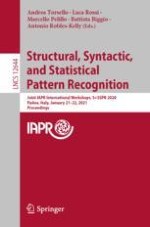2021 | Book
Structural, Syntactic, and Statistical Pattern Recognition
Joint IAPR International Workshops, S+SSPR 2020, Padua, Italy, January 21–22, 2021, Proceedings
Editors: Dr. Andrea Torsello, Luca Rossi, Prof. Marcello Pelillo, Dr. Battista Biggio, Antonio Robles-Kelly
Publisher: Springer International Publishing
Book Series : Lecture Notes in Computer Science
